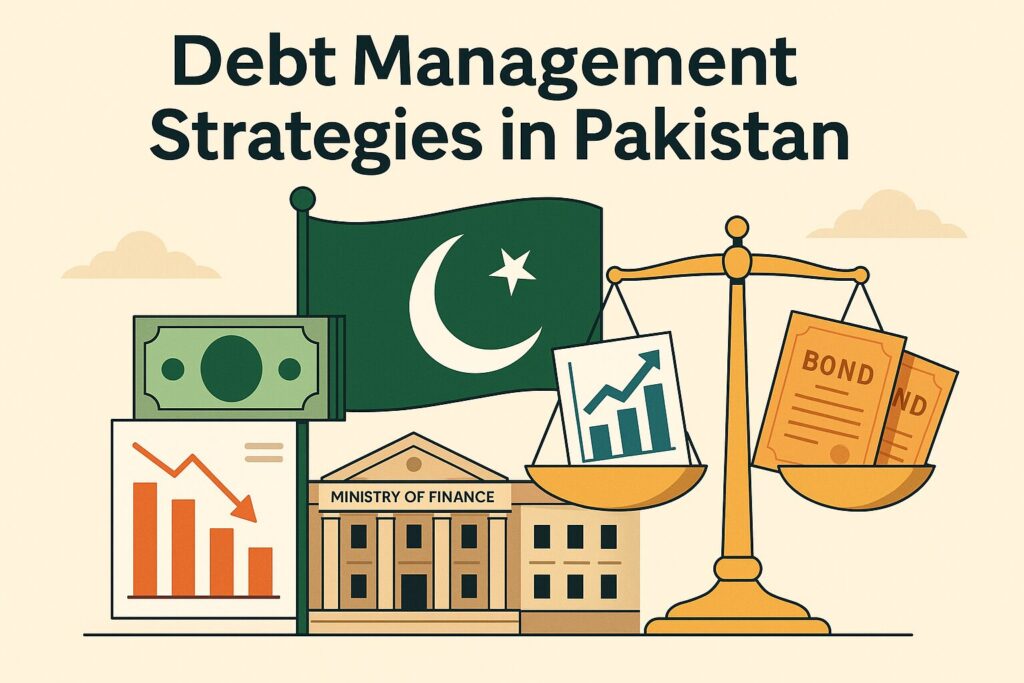
Pakistan’s debt management strategies are pivotal in navigating the tightrope between fiscal sustainability and economic growth. With public debt surpassing Rs. 62.5 trillion (approximately 80% of GDP) in FY2023 and debt servicing consuming over 50% of federal revenues, the Ministry of Finance faces a daunting task: balancing immediate financial obligations with long-term economic stability. Rising global interest rates, currency volatility, and domestic political pressures further complicate this landscape. This article examines how Pakistan manages its debt portfolio, the challenges it confronts, and the implications for macroeconomic resilience.
Current Debt Profile: Balancing Domestic and External Pressures
Pakistan’s debt composition reflects a strategic mix of domestic and external borrowing. As of 2023, domestic debt accounts for 70% of the total, primarily through government securities like Treasury Bills and Pakistan Investment Bonds. External debt (30%) includes loans from multilateral institutions (IMF, World Bank), bilateral partners (China, Saudi Arabia), and commercial creditors.
Key Debt Metrics (FY2023):
| Indicator | Value |
|---|---|
| Total Public Debt | Rs. 62.5 trillion |
| Debt-to-GDP Ratio | 80% |
| External Debt Servicing | $12.5 billion (annual) |
| Domestic Interest Rates | 15–22% (T-Bills vs. PIBs) |
The reliance on short-term domestic instruments (60% of domestic debt matures within a year) exposes Pakistan to rollover risks, while external debt repayment peaks—such as the $25 billion due in 2024–26—intensify pressure on foreign reserves.
Strategic Approaches: Mitigating Risks Through Diversification
The Medium-Term Debt Management Strategy (2023–26) prioritizes:
- Maturity Lengthening: Shifting from short-term T-Bills to long-term bonds to reduce refinancing risks.
- Domestic Market Reliance: Leveraging local banks and institutional investors to curb exchange rate vulnerabilities.
- External Diversification: Securing concessional loans from allies and issuing ESG-compliant Sukuk bonds to attract ethical investors.
For instance, Pakistan raised $1 billion through Eurobonds in 2023 and secured a $3 billion IMF Stand-By Arrangement to stabilize reserves. Additionally, the government has renegotiated bilateral debt terms with China, deferring $2.4 billion in repayments.
Challenges: Navigating Fiscal and External Headwinds
Persistent hurdles undermine debt sustainability:
- High Cost of Borrowing: Soaring domestic interest rates (22% for PIBs) inflate servicing costs.
- Currency Depreciation: The rupee’s 40% decline since 2021 escalated external debt burdens in local terms.
- Structural Weaknesses: A narrow tax base (tax-to-GDP ratio: 10%) and inefficient SOEs strain fiscal space.
Political instability further disrupts reforms. For example, delayed adjustments to energy subsidies—a key IMF condition—have periodically stalled funding, exacerbating liquidity crunches.
Implications for Economic Stability
Effective debt management is critical to avoiding a vicious cycle of borrowing for repayments. High debt servicing diverts funds from development: PSDP allocations dropped to 15% of total expenditures in 2023, stifling infrastructure and social projects. Conversely, mismanagement risks sovereign downgrades, capital flight, and inflationary financing—challenges evident in Sri Lanka’s 2022 default.
Yet, strategic measures offer hope. Extending debt maturities and securing concessional loans have temporarily eased pressures. The SBP’s monetary tightening, though increasing borrowing costs, has stabilized the rupee and curbed imported inflation.
Policy Reforms for Sustainable Debt Dynamics
To avert crisis, policymakers advocate:
- Revenue Mobilization: Expanding the tax net via digitization and taxing underutilized assets.
- Debt Transparency: Publishing granular data on SOE liabilities and contingent debts.
- Climate-Linked Financing: Leveraging global climate funds for green infrastructure, reducing reliance on traditional loans.
Pakistan’s debt trajectory hinges on structural reforms and external stability. While short-term strategies provide breathing room, long-term sustainability demands political consensus, disciplined fiscal management, and innovative financing. As global financial conditions tighten, the cost of inaction could be catastrophic.
This article was published on PublicFinance.pk.
